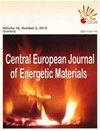聚己二酸新戊二醇阻聚皮芯结构的微孔扁圆推进剂
IF 0.6
4区 工程技术
Q4 CHEMISTRY, APPLIED
引用次数: 0
摘要
为了解决邻苯二甲酸二丁酯(DBP)对双基扁圆推进剂阻蚀后存在的高枪口闪光、高烟度、高残留、高迁移率和致癌性等问题,采用超临界二氧化碳(SC-CO2)发泡技术制备了皮芯结构微孔扁圆推进剂来代替DBP阻蚀技术。聚己二酸新戊二醇(NA)由于其在储存中的迁移率较低,被用作改变燃烧性能的威慑物。利用扫描电子显微镜(SEM)观察了不同工艺条件下微孔扁推进剂的形貌,并通过闭弹试验研究了其燃烧性能。SEM图像表明,与核心区域中的细胞相比,皮肤区域显示出更小的细胞直径和更低的细胞密度。闭式炸弹试验表明,通过控制皮芯结构和NA威慑层来调节渐进燃烧性能是可行的。原始样品、微孔样品和NA阻止样品的燃烧时间值分别为3.45、2.14,《中欧高能材料杂志》ISSN 1733-7178;e-ISSN 2353-1843版权所有©2020Łukasiewicz研究网络-波兰工业有机化学研究所50 Y.Ding,S.Ying,Z.Xiao,W.Wu,C.Li,Y.He版权所有©2021Ł。采用SC-CO2发泡皮芯结构和NA阻聚的微孔扁推进剂,为实现渐进燃烧性能提供了一种新的、有前景的方法。本文章由计算机程序翻译,如有差异,请以英文原文为准。
Microcellular Oblate Propellant with Skin-core Structure Deterred by Poly(neopentanediol adipate)
In order to solve the issues of high muzzle flash, smoke, residue, migration rate and carcinogenicity of double-base oblate propellants deterred by dibutyl phthalate (DBP), skin-core structure microporous oblate propellants to replace DBP deterring technology were fabricated in the present work by supercritical carbon dioxide (SC-CO2) foaming technology. Poly(neopentanediol adipate) (NA) was employed as the deterrent to modify the combustion properties because of ist lower migration rate in storage. Scanning electron microscopy (SEM) was used to observe the morphology of the microporous oblate propellants generated by different processing conditions, and the combustion properties were investigated by closed bomb tests. The SEM images indicated that the skin region displayed smaller cell diameters and lower cell density compared with cells in the core region. The closed bomb tests demonstrated that it was feasible to adjust the progressive combustion performance by controlling the skin-core structure and the NA deterred layer. The burning time values of the original, the microcellular, and the NA deterred samples were 3.45, 2.14, Central European Journal of Energetic Materials ISSN 1733-7178; e-ISSN 2353-1843 Copyright © 2020 Łukasiewicz Research Network – Institute of Industrial Organic Chemistry, Poland 50 Y. Ding, S. Ying, Z. Xiao, W. Wu, C. Li, Y. He Copyright © 2020 Łukasiewicz Research Network – Institute of Industrial Organic Chemistry, Poland and 4.20 ms, respectively. Microcellular oblate propellants, with a skin-core structure foamed by SC-CO2 and deterred by NA, provides a novel and promising method to realize progressive combustion performance.
求助全文
通过发布文献求助,成功后即可免费获取论文全文。
去求助
来源期刊

Central European Journal of Energetic Materials
CHEMISTRY, APPLIED-ENGINEERING, CHEMICAL
CiteScore
1.80
自引率
25.00%
发文量
0
审稿时长
>12 weeks
期刊介绍:
CEJEM – the newest in Europe scientific journal on energetic materials It provides a forum for scientists interested in the exchange of practical and theoretical knowledge concerning energetic materials: propellants, explosives and pyrotechnics. The journal focuses in particular on the latest results of research on various problems of energetic materials.
Topics:
ignition, combustion and detonation phenomenon;
formulation, synthesis and processing;
analysis and thermal decomposition;
toxicological, environmental and safety aspects of energetic materials production, application, utilization and demilitarization;
molecular orbital calculations;
detonation properties and ballistics;
biotechnology and hazards testing
CEJEM presents original research and interesting reviews. Contributions are from experts in chemistry, physics and engineering from leading research centers in Europe, America and Asia. All submissions are independently refereed by Editorial Board members and by external referees chosen on international basis.
 求助内容:
求助内容: 应助结果提醒方式:
应助结果提醒方式:


